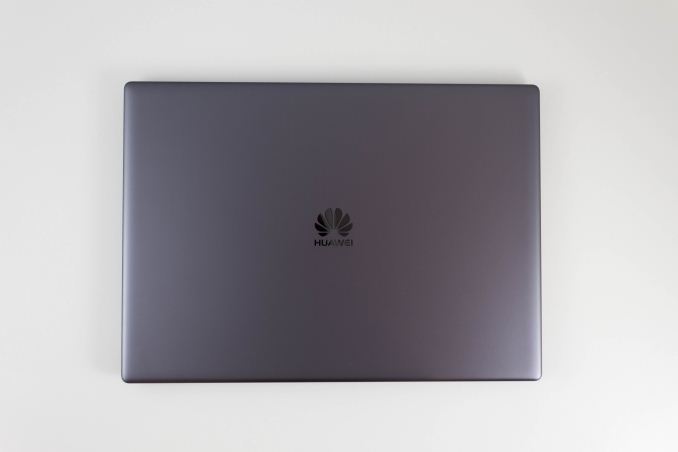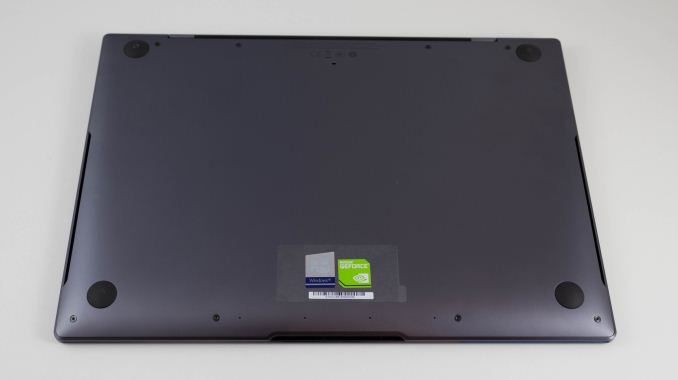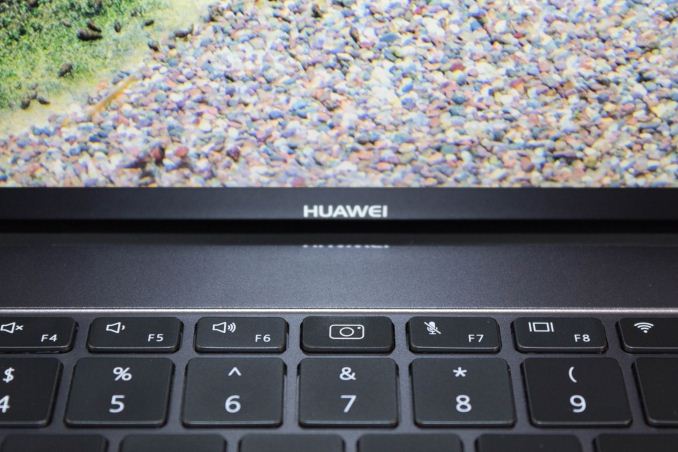The Huawei MateBook X Pro Review: Calling Out The Competition
by Brett Howse on June 27, 2018 8:00 AM ESTFinal Words
What’s perhaps most surprising about the Huawei MateBook X Pro is that the company is a fairly new entrant to the PC market, but they’ve delivered one of the best Ultrabooks you can buy in only a couple of iterations. There’s a lot of good, very little bad, and Huawei is practically sitting on an island when you talk about value.
The company seems to be unabashed about where they’ve gotten their design inspiration from for the MateBook X Pro, but despite it having a distinct MacBook Pro look to it, Huawei has delivered their own take, with amazingly thin bezels on this 3:2 display. They’ve incorporated the fingerprint reader into the power button, but there’s still an actual row of function keys too. From a design standpoint, the Huawei MateBook X Pro is one of the nicest looking Ultrabooks you can buy.
Huawei also stepped into the future with both USB-C and Thunderbolt 3, but also kept a USB-A port as well for those of us with legacy devices, which is almost everyone. It’s expansion done right. There’s no loss of device thinness either by including the USB-A port, and it sure makes life easier when you want to do almost anything. USB-C is the future, but that doesn’t mean you need to ignore the present. And for those that are still solidly in the present, Huawei ships the MateBook X Pro with a USB-C dongle with USB-A, HDMI, and somewhat strangely, a VGA connector, and even another USB-C port so you don't even lose the original port. That's a nice touch.
Huawei has delivered a good keyboard as well, despite the limited amount of key travel. They’ve done a great job on the switch resistance to make it feel like a solid keystroke. The oversized trackpad is not so oversized as to make it too easy to accidentally bump it, and it is one of the smoothest trackpads we’ve ever seen on a PC.
There’s plenty of performance as well, with the same CPU performance you’d expect in a current generation Ultrabook featuring Intel’s 8th generation U series processors, but Huawei has also added in a discrete NVIDIA GeForce MX150 GPU with 2 GB of GDDR5. It’s not a gaming system by any means, but the extra grunt from the MX150 does allow you to perform tasks that would bring the integrated UHD 620 GPU to its knees, and the combination of MX150 and Core i7-8550U outperform the Ryzen 7 2700U thanks to the CPU not sharing a TDP with the GPU.
Huawei is also one of the few PC makers to truly deliver an excellent display. The 3000x2000 resolution panel is crisp, and offers one of the highest brightness levels we’ve seen, but also some of the best contrast. The display accuracy isn’t quite class leading, but it’s close, and far better than pretty much any PC OEM other than Microsoft.
The only major complaint is the webcam placement, which is hidden under a fake function key, but depending on your needs, this could not be a real issue at all, and the ability to hide the webcam is certainly a privacy benefit. Ian has been using the MateBook X Pro as well and his experience hasn’t been as positive, with some issues with hesitation that he’s not had a chance to dig into, and he’s used the MateBook X from last year as well and prefers it to the new Pro.
With all of these features, you’d expect the MateBook X Pro to be competitively priced against a Dell XPS 13 or Microsoft Surface Pro, but that’s the real kicker. The Huawei MateBook X Pro is priced hundreds of dollars less than most of the competition, while providing a superior product to most. The value here is undeniable, even though it’s hard to think of a $1500 laptop as a value product. The base model with a Core i5-8250U, 8 GB of RAM, and a 256 GB SSD is just $1200, but unlike most laptops, the higher end model is an even better deal. For just $300 more, you bump the CPU up to a Core i7-8550U, double the RAM to 16 GB, double the SSD to 512 GB, and add in the GeForce MX150 GPU. That’s an impressive upgrade for not much more money.
Other PC makers need to stand up and take notice. The MateBook X Pro has arrived.













77 Comments
View All Comments
MrSpadge - Wednesday, June 27, 2018 - link
I really like the meaningful and fairly priced separation between the i5 and i7 model - keep it simple and the upgrade noticeable to the user.SirCanealot - Wednesday, June 27, 2018 - link
Actually, I was thinking the same thing! For the sake of $300 I can upgrade almost everything on the system. For $300 to do that, it's quite a 'may as well' situation! :)DiscoDJ - Wednesday, June 27, 2018 - link
I know the internet is international in scope, but I do find it interesting that this article doesn't even mention the security issues the U.S. Govt. (whatever you may think of it, right now) has with Huawei or ZTE. Is there an article on this site somewhere that dismisses these concerns as unfounded?RedKiwi - Wednesday, June 27, 2018 - link
Reading through the summary of the House intelligence report on Huawei and ZTE, it seems more of a "not worth the risk" type of situation. Investigating hardware provided by Huawei and ZTE was out of the scope of the investigation. The House only questioned their involvement with the Chinese government. Both companies were unable to provide a satisfactory answer to the committee. By not allowing Huawei and ZTE to sell telecommunications equipment to US carriers, it removes the possibility of snooping even if there is no risk in the first place.I do believe consumer hardware Huawei makes is safe for general use. It might not be worth it for the government to risk.
On a side note, I wish some of these decisions would be made in other parts of the US government such as environmental laws.
vanilla_gorilla - Wednesday, June 27, 2018 - link
That's one of the most reasonable replies to that question I've seen.But we can't ignore the fact that in 2017 ZTE plead guilty to illegaly exporting US technology to Iran and North Korea.
Let me say that again: Iran and North Korea. In violation of international trade sanctions.
Then when the US called them on it, they agreed to reprimand employees and pay a fine. Instead, they only fired 4 officials and provided bonuses to 35 others. That's why the US Department of Commercen banned companies from buy ZTE products.
I don't think there's much more anaysis the government needs to do. Security is all based on trust and ZTE has zero. I wouldn't trust them as far as I could throw them.
ianmills - Wednesday, June 27, 2018 - link
Well the results sound about par for how the US handled their own 2009 financial crisis hahainvinciblegod - Wednesday, June 27, 2018 - link
"But we can't ignore the fact that in 2017 ZTE plead guilty to illegaly exporting US technology to Iran and North Korea. Let me say that again: Iran and North Korea. In violation of international trade sanctions."You say that like it's a super surprising thing but you'll be surprised to learn that many companies actually make a cost benefit analysis and more often than would be expected choose to illegally export US parts to those countries. They just know that if they get caught they will pay a fine and then everything is fine. Just search "companies that violate sanctions to iran" on google and you will see how many companies do it and get caught. ZTE obviously miscalculated on how much they could get away with in the plea deal.
invinciblegod - Wednesday, June 27, 2018 - link
Also, ZTE is not Huawei.Samus - Thursday, June 28, 2018 - link
LOL I was about to say the same thing.Oxford Guy - Tuesday, July 3, 2018 - link
Yep. If the benefit (the profit) outweighs the slap on the wrist (the cost) then why wouldn't any corporation go for it? Corporations are not people. They're financial mechanisms designed to enrich some people. They just happen to have real people to do some of that work (along with AI, robotics, etc.).